The task of the child is to construct a man, oriented to his environment, adapted to his time, place and culture. – Maria Montessori
This page provides answers to your frequently asked questions (FAQs)
What are your hours?
Preschool Hours: 8:45am to 11:45am or 12:45pm to 3:45pm
Kindergarten Hours: 8:45am to 3:45pm
Language Program Hours: 11:45am to 12:45pm
Elementary Program Hours: 9:00am to 4:00pm
After School Clubs for K & Up students: 4:00pm to 5:30pm
Are there any requirements to attend your program?
All new pre-school aged children must be fully potty trained to join our program. Full details can be found on our Admissions page.
What are the student/teacher ratios?
The teaching ratio in our primary program meets the requirements of the Early Childhood Education and the Ministry of Education.
Primary (Ages 30 months to kindergarten): While licensing regulations stipulate preschools to be staffed at a ratio of 1 adult to 10 students, North Creek is staffed with 6 adults to a maximum of 40 students (a ratio of approximately 1 adult to 6.5 students).
Kindergarten students spend half-a-day in small classes comprised of 8 to 15 students.
Elementary (Grades 1 to 7): 14 to 16 students per one teacher plus assistants and specialists.
Instead of giving lessons to a large group of children, our teachers are trained to give lessons on an individual and small group basis. When the teacher is giving a child a formal presentation of a material, the assistants observe and scan the rest of the children working on a broad array of tasks. Additional staff include French, Mandarin, Art, Yoga, Music and Orton-Gillingham specialists.
How does your Primary program work?
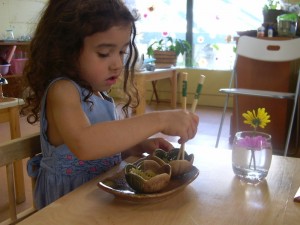 Primary Montessori is offered at our Mole Hill and North Creek facilities. Three and four-year-olds attend school five days per week in either morning or afternoon class sessions. Essential to the program is the opportunity for students to be engaged in their activities within an uninterrupted three-hour cycle each day. We provide a nurturing and carefully prepared environment, where the children’s innate interest, passion for discovery, and thirst for information are highly encouraged, by providing means and tools to engage in chosen purposeful and meaningful activities. Under the guidance of the trained directress (teacher), children are free to respond to their tendency to explore and work. Through the activities presented in each area of the classroom, children are offered the fundamental elements for optimal and joyful development of concentration, independence, self-discipline, and self-direction. The program is based on the natural development of the child and respects individual skill development, learning styles, and interests.
Primary Montessori is offered at our Mole Hill and North Creek facilities. Three and four-year-olds attend school five days per week in either morning or afternoon class sessions. Essential to the program is the opportunity for students to be engaged in their activities within an uninterrupted three-hour cycle each day. We provide a nurturing and carefully prepared environment, where the children’s innate interest, passion for discovery, and thirst for information are highly encouraged, by providing means and tools to engage in chosen purposeful and meaningful activities. Under the guidance of the trained directress (teacher), children are free to respond to their tendency to explore and work. Through the activities presented in each area of the classroom, children are offered the fundamental elements for optimal and joyful development of concentration, independence, self-discipline, and self-direction. The program is based on the natural development of the child and respects individual skill development, learning styles, and interests.
What is in the Montessori curriculum?
At the Primary Level, they are:
Practical Life – Enhancing the development of task organization and cognitive order through care of self, care of the environment, grace and courtesy, and movement.
Sensorial – Enabling the child to order, classify, and describe sensory impressions such as length, width, temperature, mass, colour, pitch and taste.
Language – Developing spoken language, written expression, reading, grammar, drama and children’s literature.
Mathematics – Using manipulative materials to present concepts of number, symbol sequence, operations and the memorization of basic facts.
Culture and the Arts – Exposing the child to our world, the people in it and their traditions through the study of geography, history, life sciences, and the arts.
The Montessori curriculum at the elementary and adolescent levels consists of Language Arts, Mathematics, Geometry, History, Geography, Science, Art, Music, French (and/or Mandarin) and Physical Education. Students in kindergarten and up are also presented lessons which meet the province’s Prescribed Learning Outcomes (PLOs).
How does your Kindergarten program work?
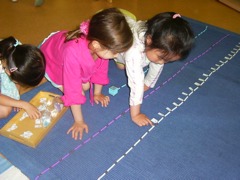 Third-year kindergarten students attend our Extended-Day program seven hours daily. Half the day is spent working in a larger group setting with pre-school students and the other half with their own peer group comprised of 10 – 13 students. The small group setting allows our teachers to focus on the individual development of each child, and the consolidation of lessons presented in the previous years with an emphasis on in-depth cultural, math, and language studies, as well as outings and other enrichment programs. This capstone year provides for students who have attended half-day Montessori preschool, the opportunity to bring their educational, social and mentorship abilities to fruition. Participation in the Extended-Day program is, therefore, extremely important for the completion of the three-year Montessori primary cycle.
Third-year kindergarten students attend our Extended-Day program seven hours daily. Half the day is spent working in a larger group setting with pre-school students and the other half with their own peer group comprised of 10 – 13 students. The small group setting allows our teachers to focus on the individual development of each child, and the consolidation of lessons presented in the previous years with an emphasis on in-depth cultural, math, and language studies, as well as outings and other enrichment programs. This capstone year provides for students who have attended half-day Montessori preschool, the opportunity to bring their educational, social and mentorship abilities to fruition. Participation in the Extended-Day program is, therefore, extremely important for the completion of the three-year Montessori primary cycle.
How are the lessons introduced to the children?
Unlike traditional education where every child learns the same thing at the same time regardless of interest or ability, we use a more individual approach. Our approach recognizes that every child has different interests and learns at a different pace. Montessorians refer to that as “following the child”.
For the most part, young first year Primary (Casa) students are given individual lessons in all areas of the curriculum following a specific sequence of activities. Children are free to work independently with whatever material on which they have received a formal presentation. A child may choose whatever appeals to him based on preference or on a specific stage of development. It is only through choices, based on true interests, that a child can engage and reach his full potential. Through observations, teachers detect true interests, assess levels of mastery and plan for either a re-presentation or the introduction of the next material to reach the appropriate challenge in the sequence. The emphasis is always on repetition and practice until mastery. While we “follow the child”, we also ensure that each child is progressing in all areas of curriculum.
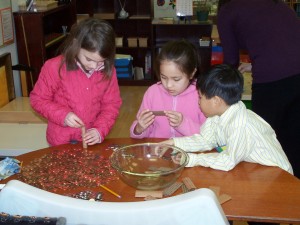 At the Elementary level, lessons are presented to groups of students. Subject areas are integrated and students are encouraged to work collaboratively with an emphasis on peer mentorship. Unlike traditional schools where curriculum is to delineate what a child is supposed to learn, lessons in Montessori elementary classes are open-ended and students are invited to study all that is of interest to them, guided by their teacher.
At the Elementary level, lessons are presented to groups of students. Subject areas are integrated and students are encouraged to work collaboratively with an emphasis on peer mentorship. Unlike traditional schools where curriculum is to delineate what a child is supposed to learn, lessons in Montessori elementary classes are open-ended and students are invited to study all that is of interest to them, guided by their teacher.
The starting point for all subject areas is the Montessori “Great Lessons”, which are present every year. These impressionistic stories based on historical and scientific findings present to the students, the “big picture” of all that exists in our universe in the areas of science, geography, history, language, math, geometry, music, and art. Follow-up lessons are then offered for the exploration on topics from these subject areas in more detail.
An authentic Montessori elementary and adolescent class is dynamic. Subjects are rarely taught in a uniform manner to the whole class. Instead, topics of study and lessons are, by and large, chosen by the students resulting the study of varied subjects at any given time. In this way, meaningful learning is nurtured by allowing students who are inspired by lessons, to explore subjects further based on their own interests.
If children work independently and are free to choose much of the work, how do you ensure they have worked sufficiently in all areas?
Teachers at all levels observe, assess and track the individual progress of the child. Students are given uninterrupted time in 3 hour-blocks to engage deeply in their learning of a particular topic. Over the course of a three-year cycle, teachers will have presented all the necessary materials in all key areas of the curriculum. They are also required to present the province’s Prescribed Learning Outcomes (PLOs) for each grade level. These lessons are incorporated as part of the Montessori curriculum.
Students at the elementary and adolescent levels have regular conferences with their teacher to review their daily work journal as well as ongoing and completed work. This allows the student and teacher to assess challenges to success and to set manageable goals for areas that need more work.
Parents receive three written reports per year. Mandatory Parent/Teacher conferences are held twice a year. In addition to the reports, individualized narratives addressing whole-child engagement, achievement, and measurable assessment of progress in all aspects of development are also presented in the first and last terms. Standardized grade assessments are provided for students in 4th grade and up. Students in grades 2, 3, 5, 8 and 9 participate in standardized Canadian Achievement Tests (CATs) while students in grades 4 and 7 participate in the province’s Foundation Skills Assessment (FSA) tests.
Why are your classrooms mixed-age?
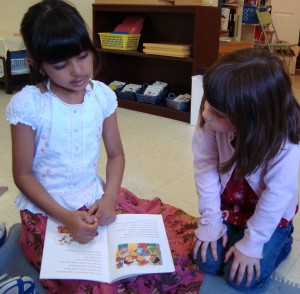 Maria Montessori stated in her book, The Absorbent Mind, that “to segregate by age is one of the cruelest and most inhuman things one can do, and this is equally true for children. It breaks the bonds of social life, deprives it of nourishment… Our schools show that children of different ages help one another. The younger ones see what the older ones are doing and ask for explanations … There are many things which no teacher can convey to a child of three, but a child of five can do it with utmost ease… In our schools, the five year old feels himself a protector of the younger one.”
Maria Montessori stated in her book, The Absorbent Mind, that “to segregate by age is one of the cruelest and most inhuman things one can do, and this is equally true for children. It breaks the bonds of social life, deprives it of nourishment… Our schools show that children of different ages help one another. The younger ones see what the older ones are doing and ask for explanations … There are many things which no teacher can convey to a child of three, but a child of five can do it with utmost ease… In our schools, the five year old feels himself a protector of the younger one.”
Our classrooms are balanced according to ages and gender. We aim to have 1/3 newcomers, 1/3 second year students and 1/3 third year students. By having different age groups interacting in the same classroom, an atmosphere where children learn to help and be helped by other children is created. They interact consistently not only with children their age, but also with those children of varying ages and abilities. That way, children gain an appreciation for not only their own accomplishments but also the achievement of others. They also observe more complex work and learn peripherally. Older children learn how to be patient and tolerant, and how to model appropriate behaviour. They serve as mentors to inspire the younger children, which allows for complete mastery of their attained skills and reinforcement of previously learned concepts. Younger children learn about courtesy, manners, and expected behaviours, as well as conflict resolution, by watching the older children on a daily basis.
What is your approach to discipline?
Grace and Courtesy lessons are the basis for our proactive approach to discipline. Teachers demonstrate expected behaviour and model appropriate language at all times informally or formally through lessons and role-playing. Children have the chance to practice appropriate social behaviour before encountering conflicts. These lessons are the foundation of the classroom, as they set a tone of respect and kindness. Teachers set clear expectations and boundaries within the classroom. We help children learn that they are responsible for what they do and that their actions have natural consequences.
Part of our approach is to redirect energy from destructive to constructive with the aid of the Montessori activities. The few ground rules in our classroom are reinforced and modeled in a gentle, consistent and respectful manner by the older children. This ensures that the younger child adapts to the environment promptly. In the event of a more serious issue, teachers work closely with families to develop a plan to ensure consistency at home and at school.
Above all else, our goal is to lead the child towards self-discipline. We do this by helping our students develop their will-power and self-control through the practice of diligence, patience, and acceptance for oneself and others in an environment that balances freedom with responsibility. Students are given the opportunity to experience how others respond (both positively and negatively) to their choices and actions, which leads to the awareness and understanding of acceptable and appropriate behaviour.
The promotion of strong work habits coupled with guided freedom of choice is essential. Students engage in exercises and lessons that require them to learn how to control and coordinate themselves – their bodies, their movement, their speech, their time and even their thoughts. The mastery of those skills developed through practice and mindful diligence leads the child to the ultimate goal of self-government.
In addition to this, Vancouver Coastal Health provides us a Health Nurse who is available as a resource and support.
What is the structure of the classroom?
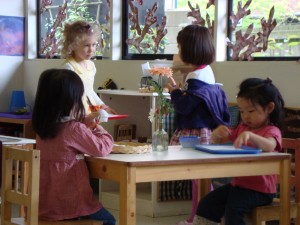 Our environments at all levels are arranged according to subject areas, and students are free to move around the room instead of staying at desks. Seating is not assigned and students can choose to work at a table or on a floor mat. They are in essence, guided free-range environments supported by the framework of freedom and responsibility.
Our environments at all levels are arranged according to subject areas, and students are free to move around the room instead of staying at desks. Seating is not assigned and students can choose to work at a table or on a floor mat. They are in essence, guided free-range environments supported by the framework of freedom and responsibility.
Teachers present lessons to students throughout the day. Having received those lessons, students are empowered to work on activities and lessons based on their interests and abilities while meeting the Prescribed Learning Outcomes (PLOs) for their respective grades. At any one time in a day, all subjects (math, language, science, botany, geography, art, zoology, etc) are being studied, at all levels.
At the primary level, young children ages 3 to 4 years of age typically engage in activities with a focused on the process rather than the product, so you will not see your child bring home a large amount of “work”. For the most part, the materials have a built-in control of error that allows the child to self-correct, thereby reducing dependency on external recognition.
Our teachers are careful to avoid the use of false praise. Instead, the student’s efforts are respected and on-going practice is encouraged so as to lead the student towards self-mastery of an activity or lesson. The teacher, through extensive observation and record-keeping, plans individual and group presentations to enable each child to learn what he needs to progress or to improve.
How do the language lessons work?
Language programs for pre-school (half-day) students in French and/or Mandarin are available from 11:45am to 12:45pm, Monday through Thursday. Newcomers are expected to be fully adapted to the 3-hour Montessori work cycle before they are considered eligible to join language lessons. Kindergarten to grade 4 are eligible participate in French and Mandarin lessons twice a week for 30 minutes. Core French lessons are mandatory for students in grades 5 to 8 while Mandarin lessons are optional.
My child is three years old, and about to start preschool. What activities will he/she be involved in?
 When your child begins in our Primary program, he will start receiving formal presentations in the areas of Spoken Language, Sensorial, and especially Practical Life. Through extensive observations, Maria Montessori has noticed that children are naturally interested in activities they have witnessed in their lives and homes. Practical Life exercises in the classroom are a foundation for the Montessori program and for the studies in other areas such as Written Language, Reading and Math. These activities allow the children to perform real life tasks that instill care for self, others and the environment. Activities such as pouring, polishing different types of materials, washing a table, the dressing frames, sweeping, and preparing snack allow the children to engage in purposeful and meaningful tasks developing muscular coordination and manual dexterity. By gaining control of their movements, the children become more independent, adapted and orientated to their classroom community and society. Practical Life exercises also foster concentration, the development of the child’s intellect and an orderly way of thinking. In addition, grace and courtesy exercises present the children with elements of human conviviality and how we interact with each other in different social contexts. Control of movement exercises give the children the opportunity to learn about their own body, control their movements and refine their gross motor skills. Practical Life exercises provide the basis for mental, physical and social development that contribute to further successes in academics and life.
When your child begins in our Primary program, he will start receiving formal presentations in the areas of Spoken Language, Sensorial, and especially Practical Life. Through extensive observations, Maria Montessori has noticed that children are naturally interested in activities they have witnessed in their lives and homes. Practical Life exercises in the classroom are a foundation for the Montessori program and for the studies in other areas such as Written Language, Reading and Math. These activities allow the children to perform real life tasks that instill care for self, others and the environment. Activities such as pouring, polishing different types of materials, washing a table, the dressing frames, sweeping, and preparing snack allow the children to engage in purposeful and meaningful tasks developing muscular coordination and manual dexterity. By gaining control of their movements, the children become more independent, adapted and orientated to their classroom community and society. Practical Life exercises also foster concentration, the development of the child’s intellect and an orderly way of thinking. In addition, grace and courtesy exercises present the children with elements of human conviviality and how we interact with each other in different social contexts. Control of movement exercises give the children the opportunity to learn about their own body, control their movements and refine their gross motor skills. Practical Life exercises provide the basis for mental, physical and social development that contribute to further successes in academics and life.
Do you have circle time?
Since we follow the child, we do not have a structured daily circle time. However, teachers or older children often gather small groups of interested children to read stories, sing songs or have conversations whenever appropriate.
What if my child is hungry during the 3-hour work cycle?
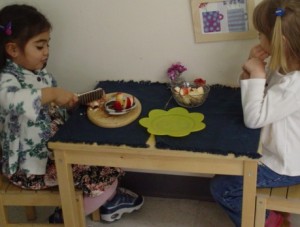 Snack consisting of organic fruits, vegetables, and cereal is provided by the school. You may also pack a special snack from home for your child. Note that we do not have a structured snack time. Rather, the children are welcome to sit at our snack table (2 people at a time) at any given moment. We encourage the children to self-regulate and be in touch with their bodily needs. Therefore, we allow them to have snack whenever they feel the need. If bringing snack from home, they are expected to remove it from the containers/bags and place it on appropriate plates or bowls. Please refrain from sending any type of sugary snacks or juice boxes. Certain foods such as peanuts and peanut products will be omitted from our school snack entirely if the Head of School deems it to be hazardous. Class allergy information is sent out at the beginning of each year, and updated as necessary. We ask all families to be sensitive to students’ allergies and avoid sending snacks that contain substances that may cause allergic reactions.
Snack consisting of organic fruits, vegetables, and cereal is provided by the school. You may also pack a special snack from home for your child. Note that we do not have a structured snack time. Rather, the children are welcome to sit at our snack table (2 people at a time) at any given moment. We encourage the children to self-regulate and be in touch with their bodily needs. Therefore, we allow them to have snack whenever they feel the need. If bringing snack from home, they are expected to remove it from the containers/bags and place it on appropriate plates or bowls. Please refrain from sending any type of sugary snacks or juice boxes. Certain foods such as peanuts and peanut products will be omitted from our school snack entirely if the Head of School deems it to be hazardous. Class allergy information is sent out at the beginning of each year, and updated as necessary. We ask all families to be sensitive to students’ allergies and avoid sending snacks that contain substances that may cause allergic reactions.
How can I ensure that my home life is consistent with the Montessori approach?
There are many ways that you can use the Montessori principles at home. “Help me do it by myself” is the motto of a preschooler. Find ways to involve your child in daily activities such as meal preparation, cleaning, gardening, caring for clothes, shoes, and toys. Take the time to demonstrate as well as allow the time for the child to practice the technique of use for any frequently used tool, utensil, appliance, article of clothing, and the like. This provides the child with the opportunities to develop independence and self-confidence. In addition, some concepts such as protecting concentration can be reinforced in the home as well. For example, if you witness your child playing independently in a state of deep concentration, resist the urge to step in and join the activity. If a situation arises, allow your child to work through activities on their own rather than to try to solve it for him/her. It is best to refrain from excessive, redundant praise when a child succeeds in their endeavor; allowing genuine pride to develop from within is key to the fostering a child’s own sense of self-worth and confidence.
Above all else, shower your child with love. Spend time sharing your delight in them: Listen to their stories and take the time to witness even their smallest joys and accomplishments.
How are physical activities incorporated into the program?
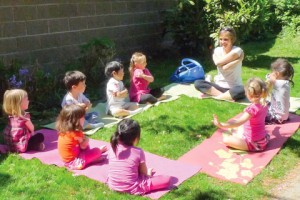 Maria Montessori believed that the children’s growing bodies and intellect need movement: They need it for physical development, to stay healthy, to help manage emotional change, and to keep their minds focused and alert. Our program uses age-appropriate activities to give many opportunities for the children to move their bodies and develop control of movement and gross motor skills. Children are given freedom of movement in the classroom, provided they are respecting the concentration and activity of others. Children are constantly moving in our classroom. They carry objects, trays, chairs and tables. They carry materials from one mat to the other or from a shelf to a table. Also, they participate in music and movement activities such as Walking on The Line, dancing, marching, stretching, and yoga once a week. Additionally, we take advantage of being located closely to the seawall, parks and beaches. Our Extended-day students visit these neighborhood places daily. Please make sure that your child is dressed appropriately for the weather at all times (rubber boots and a hooded raincoat are a must!).
Maria Montessori believed that the children’s growing bodies and intellect need movement: They need it for physical development, to stay healthy, to help manage emotional change, and to keep their minds focused and alert. Our program uses age-appropriate activities to give many opportunities for the children to move their bodies and develop control of movement and gross motor skills. Children are given freedom of movement in the classroom, provided they are respecting the concentration and activity of others. Children are constantly moving in our classroom. They carry objects, trays, chairs and tables. They carry materials from one mat to the other or from a shelf to a table. Also, they participate in music and movement activities such as Walking on The Line, dancing, marching, stretching, and yoga once a week. Additionally, we take advantage of being located closely to the seawall, parks and beaches. Our Extended-day students visit these neighborhood places daily. Please make sure that your child is dressed appropriately for the weather at all times (rubber boots and a hooded raincoat are a must!).
Elementary students participate in an organized physical education program and participate in such activities as dance, soccer, tennis, floorball, cross fit, swimming, and martial arts.
Are there any articles or research on the efficacy of Montessori education?
The website, http://montessori-science.org/ has many articles for your review. Outcomes for Students in a Montessori Program was conducted by NCERI (The National Center on Educational Restructuring and Inclusion, the Graduate School and University of New York) on the efficacy of Montessori education in Milwaukee Public Schools. This and other reports can be found at http://www.montessori-ami.org/research/research.htm.
I don’t know anyone who attended Montessori. Can you name a few examples?
Visit our Parent’s Perspective page to view what some parents have to say about Montessori as well as a video with NBA champion, Steph Curry.
Some publicly known Montessori students include:
- Devi Sridhar – Youngest-ever American Rhodes scholar, author, oxford research fellow, oxford lecturer on global health politics
- Joshua Bell, American violinist and subject of a Pulitzer prize-winning media story
- Jeff Bezos, founder of Amazon.com
- Dr. Terry Brazelton, noted pediatrician and published author on child psychology
- Sergey Brin and Larry Page, co-founders of Google
- Will Wright, designer of The Sims video games
- George Clooney, Academy Award-winning actor
- Chelsea Clinton, daughter of Bill and Hillary Clinton
- Dakota Fanning, Actress
- Taylor Swift, Singer/Songwriter
- Beyonce, Singer
- David Blaine, Magician
- John and Joan Cusack – Actor and screenwriter, and Academy award-nominated actress, respectively
- Julia Child, first world-famous television chef
- Anne Frank, renowned World War II diarist
- Friedensreich Hundertwasser, Austrian painter and architect
- Gabriel Garcia Marquez, Nobel Prize winner for Literature
- Katherine Graham, owner-editor of The Washington Post
- Prince William and Prince Harry, sons of Charles, Prince of Wales
- Helen Hunt, Academy Award-winning actress
- Helen Keller, Political activist, author, lecturer, awarded the presidential medal of freedom, one of gallup’s most widely admired people of the 20th century
- Jacqueline Bouvier Kennedy Onassis, former editor, former first lady
Here are some thoughts on Montessori by Steve Wozniak (co-founder, Apple), Larry Page and Sergey Brin (founders, Google).
Others connections with Montessori:
- Alexander Graham Bell, noted inventor, provided financial support directly to Dr. Montessori, helped establish the first Montessori class in Canada and one of the first in the United States
- Bruno Bettelheim, noted psychologist/author, was married to a Montessori teacher
- Thomas Edison, noted scientist and inventor, helped found a Montessori school
- Erik Erikson, anthropologist/author, had a Montessori teaching certificate
- Mahatma Ghandi, political and spiritual leader of India for human rights and non-violence
- Jean Piaget, noted Swiss psychologist, made his first observations of children in a Montessori school
- Mister Rogers, children’s TV personality, strong supporter of Montessori education
- President Wilson’s daughter trained as a Montessori teacher. There was a Montessori classroom in the basement of the White House during Wilson’s presidency.
Are there any articles or books I can read about Montessori?
Yes. In the “Reaching Beyond” section on our website, you can find interesting articles, provocative news, ideas and experiences, on Montessori and beyond. Also, you may want to read the following books available from our BookStore:
● The Absorbent Mind by Maria Montessori This is, perhaps, Dr Maria Montessori’s most in-depth work on her educational theory, based on decades of scientific observation of children. Her view on children and their absorbent minds was a landmark departure from the educational model at the time. This book helped start a revolution in education. The Absorbent Mind takes its title from the phrase that the inspired Italian doctor coined to characterize the child’s most crucial developmental stage: the first six years.
● Montessori Madness by Trevor Eissler The father of three Montessori students, a business jet pilot, author, and international speaker, Trevor Eissler explores how Montessori education best prepares children for the world outside the classroom.
● Montessori: The Science behind the Genius by Angeline S. Lillard In this book, Lillard presents the research behind eight insights that are foundations of Montessori education, describing how each of these insights are applied in the Montessori classroom. In reading this book, parents and teachers alike will develop a clear understanding of what happens in a Montessori classroom and, more importantly, why it happens and why it works.
© Lions Gate Montessori
